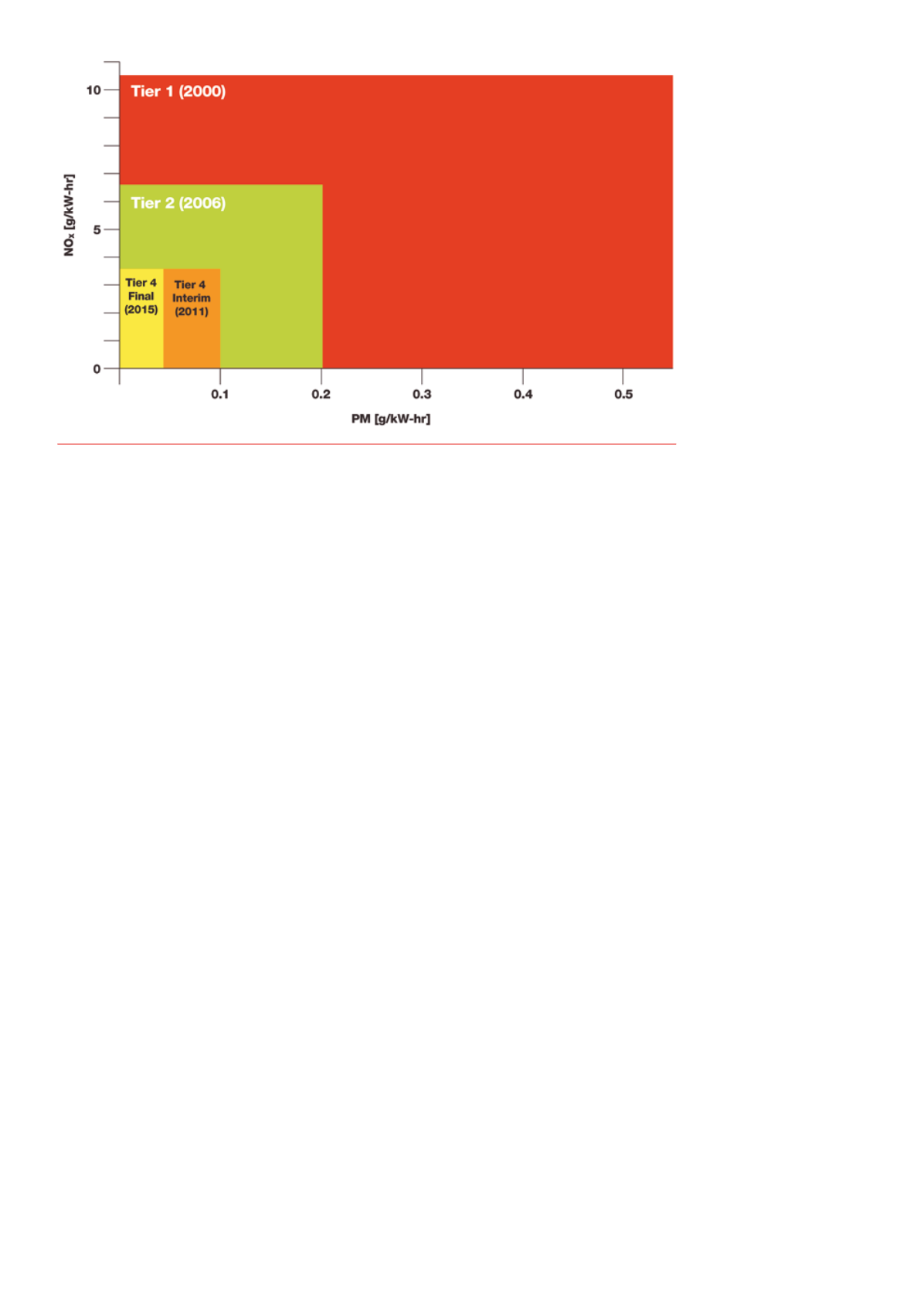
44 |
Oilfield Technology
December
2014
The Tier 4 Final emissions standards require the first significant
shift in engine technology for the oil and gas industry in nearly 10 years,
and also represent an opportunity for enginemanufacturers to
differentiate themselves by providing users with cleaner, quieter and
more cost‑efficient engines through technical innovation and product
performance.
Challengesposedbynewstandards
The key challenge posed by Tier 4 Final lies in complying with the
stringent standards while simultaneously satisfying customer
expectations. Every enginemust comply with the EPA’s PM and
NOx limits. At the same time, customers continue to expect higher
standards of reliability and performance, better fluid efficiency and
engines that fit within existing equipment designs. The introduction
of new emissions reduction technology is necessary to keep these
competing objectives frombecomingmutually exclusive. Cummins
has achieved these objectives through the use of selective catalytic
reduction (SCR).
SCR technology is not new; it has been deployed inmultiple
markets around the world for close to a decade. The Cummins
SCR aftertreatment system is a completely passive, flow‑through
system for NOx reduction. SCR aftertreatment systems use a catalyst
and diesel exhaust fluid (DEF) to eliminate NOx fromengine exhaust
and PM is controlled in‑cylinder through optimised combustion.
SCR aftertreatment systems require DEF, which is pumped via
lines froma tank to the DEF doser. Once engine exhaust enters the
SCR aftertreatment system, a controlled volume of DEF is injected into
the exhaust streamwhere it atomises and decomposes into ammonia
and water vapour. This catalyses the DEF and NOx, producing nitrogen,
carbon dioxide and water vapour as exhaust that meets the Tier 4 Final
NOx standard.
Another common technique used to reduce NOx emissions is cooled
exhaust gas recirculation (CEGR). CEGR is an emissions reduction process
where exhaust gas is taken from themain exhaust stream following
combustion, cooled, and recirculated into the combustion chamber
after it is mixed with fresh air. By reintroducing exhaust gas into the
combustion process, less oxygen is present during combustion, reducing
combustion temperature and in‑cylinder NOx production. Cummins uses
CEGR to great effect in engines below 751 horsepower, but its efficiency
drops as engines move beyond
the 751 horsepower threshold.
Sole reliance on CEGR to
meet emissions can result in
significant increases in the heat
rejection generated by cooling
the exhaust gas. Overall engine
system space claimmay grow
significantly as a result. Cylinder
pressure is also increased in
CEGR‑only systems, which
increases mechanical stresses
in the engine and requires
increased fuel systempressure
in order tomaintain low
PM emissions. Supplemental
technologies are required
in conjunction with CEGR to
meet Tier 4 Final NOx emission
limits without burdening the
systemwith oversized cooling
packages. The efficiency
of Cummins’ SCR systems
eliminates the need to use CEGR for NOx reduction and allows the
company’s Tier 4 Final high‑horsepower engines tomaintain Tier 2 heat
rejection levels and cooling packages.
Pressurepumpingfor theoil andgas industry
Cummins’ Tier 4 Final engine technology and SCR aftertreatment system
are the latest entries in a long history of product innovation. Cummins
was the first enginemanufacturer tomeet the EPA’s four most recent
on‑highway emissions standards and the first to announce engine
technology for the 2006 Tier 2 standards. The ability to consistently be
the first tomarket with emissions‑compliant products is a direct result
of the company’s in‑house design andmanufacturing capability for its
engine and emissions reduction technologies. SCR technology dates
back to 2005 with the introduction of the Euro IV on‑highway standards
and since, the company’s proprietary SCR technology has logged almost
2 billion hrs of use inmore than 10 different industries. This experience
provides a firm foundation for the common aftertreatment architecture
used across the company’s entire oil and gas product range.
Cummins was the first to announce Tier 4 Final products for the
pressure pumpingmarket. The QSK50 for pressure pumping, rated
at 2250 ‑ 2500 horsepower, was certified six months ahead of the
1 January 2015 effect date. A significant 33 000 hrs of severe field‑testing
validated the systemarchitecture. Production of the QSK50 will begin
in the fourth quarter of 2014. The QSK50 is the first of the Cummins
high horsepower Tier 4 Final engine family to reach production, with
the rest released in accordance with customer demand. The QSK50 is
popular in the pressure pumpingmarket because of its ability to handle
the tough and demanding load factors required.
Power, performance and availability are critical to the oil and gas
industry. With new and improved technologies, the pressure pumping
engines harness the competitive advantages of their Tier 2 predecessors,
meeting and exceeding Tier 2 benchmarks, reducing product complexity.
Every Cummins Tier 4 Final engine is built for the same high load
factors and annual use as Tier 2 engines and delivers identical power
density, performance and simplicity. The power cylinders and high
pressure, modular common rail fuel system (MCRS) enable each
engine to provide power and torque output equal to or better than
those of Tier 2 engines and reduce fuel consumption at the same
time. Both the exhaust gas temperatures and in‑cylinder pressure
Figure 1.
EPA nonroaddiesel equipment Tier 4 emissions chart.


